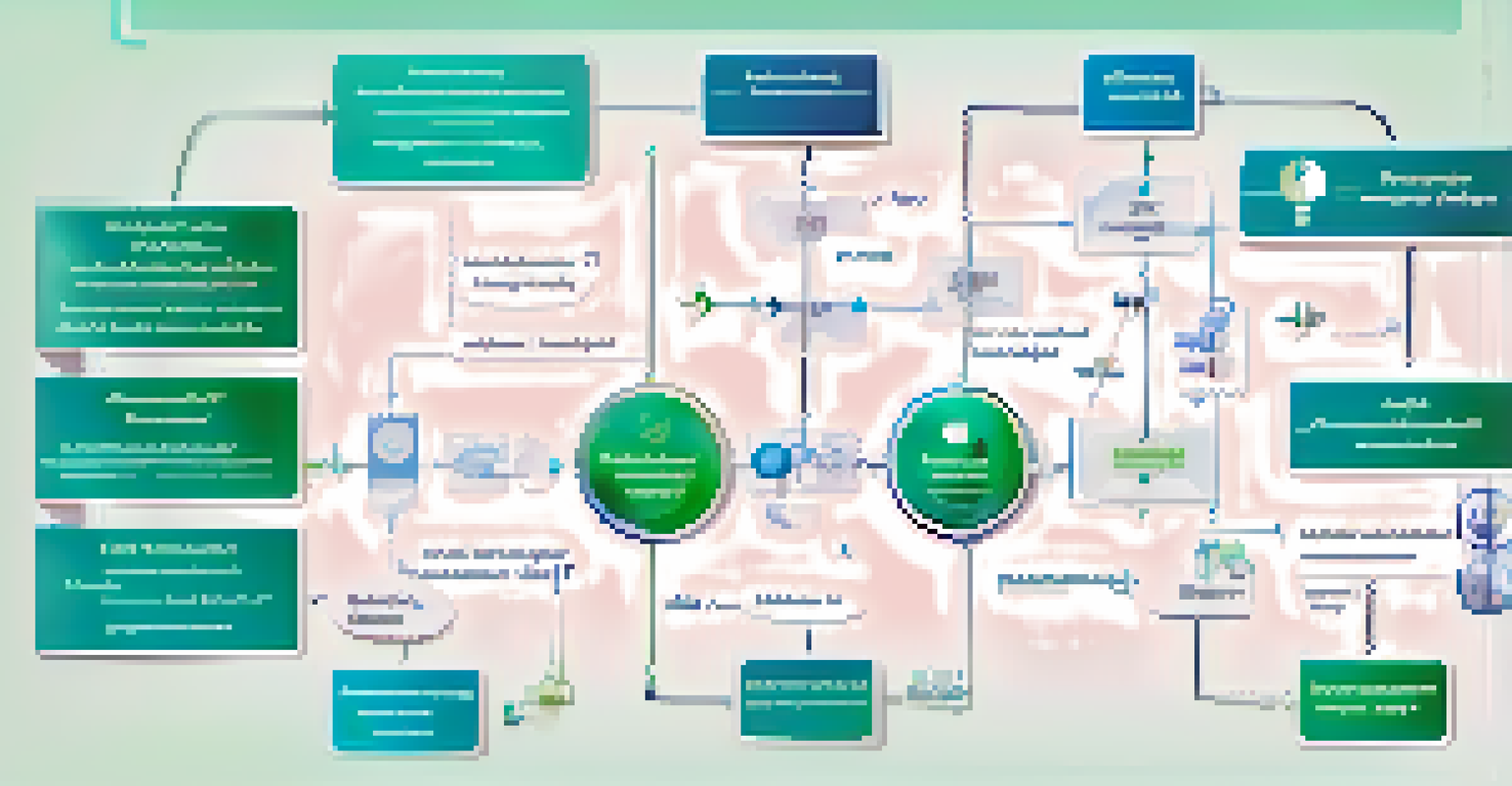Cost-Effectiveness of Medications: A Policy Perspective

Defining Cost-Effectiveness in Medications
Cost-effectiveness in medications refers to the evaluation of the economic value of a drug compared to its health benefits. Essentially, it looks at how much money is spent to achieve a certain health outcome, often measured in terms of quality-adjusted life years (QALYs). This metric helps healthcare policymakers decide which treatments provide the best value for money.
Cost-effectiveness analysis is not just about money; it's about making sure we use our healthcare resources wisely to benefit as many patients as possible.
For instance, if a new cancer drug costs significantly more but only extends life by a few months compared to an existing treatment, cost-effectiveness analysis can highlight this disparity. It allows stakeholders to weigh the financial burden against the benefits patients receive. Understanding this ensures that limited healthcare resources are used efficiently.
In many countries, cost-effectiveness analysis is a crucial part of the drug approval process. By incorporating these evaluations, health authorities can prioritize medications that deliver the most significant health gains relative to their costs, ultimately shaping a more sustainable healthcare system.
The Role of Health Technology Assessment (HTA)
Health Technology Assessment (HTA) is a systematic process that evaluates the social, economic, organizational, and ethical issues of a health intervention. HTA plays a pivotal role in determining the cost-effectiveness of medications, providing evidence that informs policy decisions. It helps ensure that any new drug introduced into the market is not only effective but also justifiable in its cost.

For example, when assessing a vaccine, HTA would consider not just the drug's efficacy but also its cost implications for the public health system. This comprehensive approach allows for a more informed discussion about resource allocation. In essence, HTA serves as a bridge between clinical evidence and policy-making, ensuring that decisions are grounded in solid data.
Cost-Effectiveness Guides Drug Value
Cost-effectiveness analysis evaluates the economic value of medications by comparing their costs to health benefits, influencing policy decisions.
Moreover, HTAs are often used by government bodies and insurance companies to establish pricing and reimbursement policies. Through HTA, policymakers can identify which treatments should receive funding and which should be excluded, thus maintaining a balance between innovation and fiscal responsibility.
Impact on Drug Pricing and Accessibility
Cost-effectiveness analysis significantly influences how medications are priced and accessed by patients. When a medication is deemed cost-effective, it is more likely to receive favorable pricing, making it accessible to a larger population. Conversely, drugs that do not meet cost-effectiveness thresholds may face higher prices or restrictions on their use.
The challenge in healthcare is not just to find effective treatments, but to ensure they are available to those who need them most, regardless of their economic status.
Take, for example, life-saving treatments for chronic conditions. If these treatments are shown to provide substantial benefits at a reasonable cost, health insurers are more inclined to cover them. This not only benefits patients who need the medication but also promotes public trust in the healthcare system.
However, the challenge arises when high-cost medications are introduced that may not demonstrate sufficient cost-effectiveness. Policymakers must then navigate the delicate balance between encouraging pharmaceutical innovation and ensuring that essential medications remain affordable and accessible to those who need them.
Ethical Considerations in Cost-Effectiveness
While cost-effectiveness is a critical factor in healthcare policy, it raises several ethical considerations. One major concern is whether it is fair to prioritize treatments based on economic evaluations, potentially sidelining the needs of the most vulnerable populations. Ethical frameworks must guide the decision-making process to ensure equity in healthcare access.
For instance, a medication that is cost-effective for a majority may still be out of reach for specific groups, such as low-income patients. This leads to questions about justice and the moral obligation of the healthcare system to provide equitable care. Policymakers must address these dilemmas to create a system that values both efficiency and compassion.
HTA Ensures Informed Policy Decisions
Health Technology Assessment (HTA) systematically evaluates health interventions to ensure new drugs are both effective and financially justifiable.
Moreover, cost-effectiveness should not be the only metric used in evaluating medications. Factors such as individual patient needs, cultural context, and potential outcomes must also be considered to create a holistic approach to healthcare policy. Engaging with diverse stakeholders can help ensure that ethical considerations are integrated into the decision-making process.
Global Perspectives on Medication Cost-Effectiveness
Different countries approach the cost-effectiveness of medications in various ways, influenced by their healthcare systems and economic contexts. For example, in the United States, the focus is often on market-driven solutions, whereas countries like the UK utilize the National Institute for Health and Care Excellence (NICE) to guide their cost-effectiveness evaluations. This diversity reflects how cultural values shape healthcare policy.
In some low-income countries, affordability takes precedence over cost-effectiveness, leading to different priorities in healthcare spending. These nations may prioritize basic health interventions rather than expensive medications, highlighting the need for tailored approaches. Understanding these differences can provide valuable insights into the global landscape of medication accessibility.
Furthermore, international collaborations can enhance the understanding of cost-effectiveness across borders. Sharing best practices and lessons learned can foster more effective policies that consider both local and global health challenges, ultimately improving health outcomes for diverse populations.
Future Trends in Cost-Effectiveness Analysis
As healthcare continues to evolve, the methodologies for cost-effectiveness analysis are also advancing. Innovations in technology and data analytics are enabling more precise evaluations of medication value. For instance, real-world evidence is becoming increasingly important in understanding how drugs perform outside clinical trials, leading to more informed policy decisions.
Additionally, the rise of personalized medicine presents new challenges and opportunities for cost-effectiveness analysis. As treatments become tailored to individual genetic profiles, evaluating their cost-effectiveness may require new models that account for variability in patient responses. The healthcare landscape is shifting, demanding that policymakers adapt their approaches accordingly.
Ethics and Equity in Healthcare Policy
While cost-effectiveness is essential, ethical considerations must ensure that healthcare access remains equitable for vulnerable populations.
Finally, we may see a growing emphasis on social determinants of health in cost-effectiveness evaluations. By incorporating factors such as socioeconomic status, access to care, and community resources, future analyses can create a more comprehensive picture of medication value. This shift could lead to more equitable healthcare solutions that address the root causes of health disparities.
Conclusion: Balancing Cost and Care in Healthcare Policy
In conclusion, understanding the cost-effectiveness of medications is crucial for developing effective healthcare policies. By integrating cost analyses into decision-making processes, policymakers can ensure that resources are allocated efficiently while maximizing health benefits for the population. Striking this balance is essential for the sustainability of healthcare systems worldwide.
However, it is equally important to consider the ethical implications and the diverse needs of patient populations. Policymakers must remain vigilant in ensuring that cost-effectiveness does not overshadow the fundamental goal of providing equitable and accessible care for everyone. Engaging with different stakeholders can help create a more inclusive approach to healthcare.

Ultimately, cost-effectiveness analysis should serve as a tool for improvement, guiding the development of innovative treatments while safeguarding the health of communities. As we move forward, fostering collaboration and open dialogue among all healthcare stakeholders will be key to achieving a balanced and effective healthcare system.